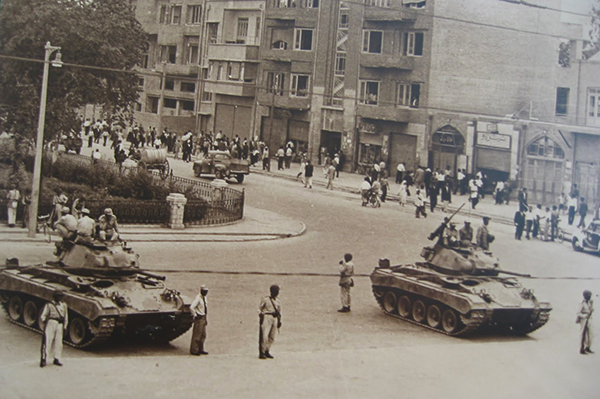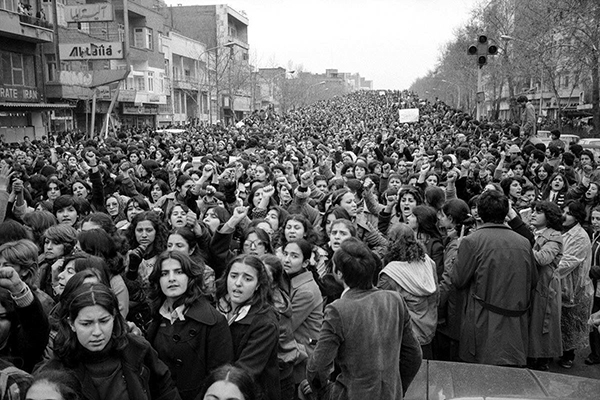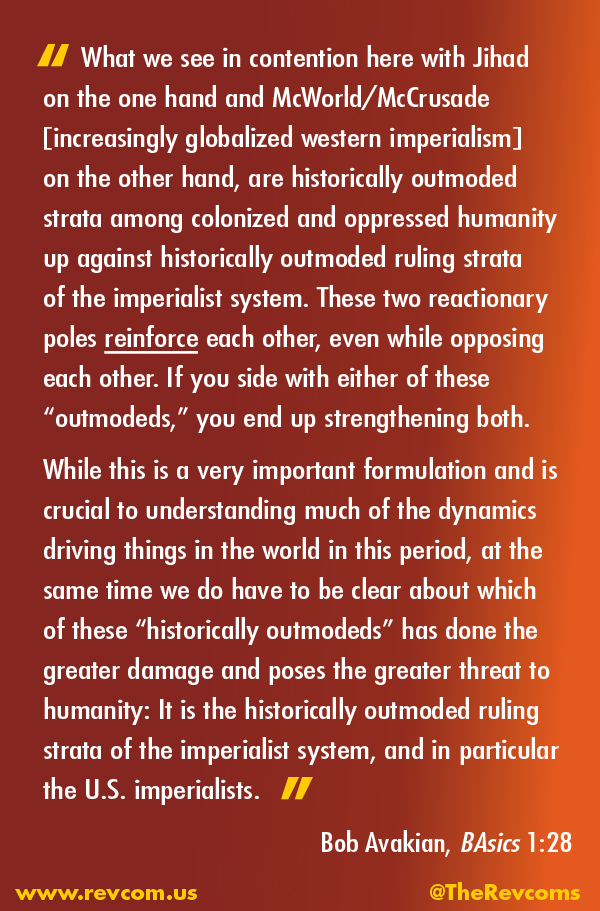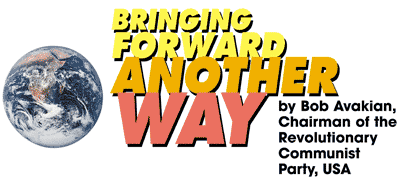As the U.S. Ratchets Up War Moves Against Iran …
and as Iran Steps Up Its Repression Against Its People …
What Are the Stakes for Humanity?
| revcom.us
Introduction: A People in the Crosshairs, a World at the Brink
In the past few weeks the U.S., in league with its ally and henchman Israel, has been threatening and attacking Iran. Most recently, one of Iran’s top nuclear technology scientists was assassinated. Iran accused Israel, and Israel has not denied this. Earlier, U.S. media reported that Trump had asked his military commanders and strategic policy makers for a plan to bomb Iranian nuclear technology labs. The advisers reportedly persuaded him not to. Trump did not deny asking for such plans, and there is still talk that he may launch some sort of attack.
The U.S. and Israel say they must prevent Iran from gaining nuclear weapons. Yet the U.S. itself has thousands of nuclear weapons capable of hitting “targets” in large parts of the world, and Israel reportedly has close to 100, some that are no doubt aimed at Iran. Any war between Iran and either the U.S. or Israel could easily get “out of hand,” and the imperialists could end up deciding to use one of its nuclear bombs to pulverize Iran—with genocidal consequences for the 80 million human beings who live in Iran, and potentially catastrophic consequences for the world. In other words, every day, 24-7, the U.S. holds a gun to the heads of humanity and to Iran in particular—and yet they try to act as if they are the victim!
The U.S. says that it must also prevent Iran from gaining strength and influence in the Middle East region (see map). Yet the U.S. itself has dominated the region for years with military aid and use of puppets and proxies, keeping the people murderously suppressed and exploited.1
Sometimes the U.S. even says it cares about the freedom and well-being of the Iranian people. Yet these attacks come on top of years of punishing economic warfare against Iran—economic warfare which has caused tremendous hardship, suffering and death among its people. And, as this article will show, the U.S. has, under Republican and Democrat alike, supported regimes just as repressive as the one currently ruling Iran.
So why is the U.S. doing this? To understand this, we need to step back. We need to look at history, and we need to look at dynamics and forces that almost never get reported on in the media or, when they are, represented correctly.
Two Centuries of Imperialist Domination
Iran traces its culture back to the Persian empire that arose some 2,500 years ago. This was a culture of great achievements—and, like all empires before and since, it rested on the brutal exploitation and horrendous suffering of masses of people, including through savage wars of conquest, generation after generation. As time went on, this empire was defeated and replaced by other empires.
Iran possesses huge reserves of oil. With the rise of capitalism, and then imperialism, oil became immensely important to production—and immensely profitable. Oil is a resource crucially necessary to run a modern economy, within the current setup of things. That means that those countries which control oil—either because they have those resources in their country, or because they dominate other nations that have such resources—have tremendous power. Iran not only possesses such oil itself, it is in the middle of a region in which there are other large reserves of oil.
Beginning in the 1800s, Britain—then the world’s dominant imperialist power—exerted control and domination of Iran, exploiting its resources and people for their empire. Then after World War II, the U.S. took over. When a nationalist Iranian politician, Mohammad Mossadegh, came to power in a democratic election, he promised to nationalize the oil—that is, to make it the property of the Iranian state—and the CIA engineered a violent military takeover to remove Mossadegh and replace him through a puppet, Reza Pahlavi, who styled himself the Shah, or king, of Iran.
For decades, the U.S. controlled this oil through this puppet Shah that they violently installed. U.S. presidents, Democrat and Republican alike, gave billions to the Shah, building up and training his army and the notorious Iranian spy agency—the SAVAK—in surveillance, infiltration and torture. In 1976, Amnesty International reported that Iran had the “highest rate of death penalties in the world, no valid system of civilian courts and a history of torture which is beyond belief. No country in the world has a worse record in human rights than Iran.”2 The U.S. rulers bound the Iranian economy to the U.S. and other imperialist powers in an oppressive relationship. They tore up and reshaped agriculture and industry to serve the needs, and the superprofits, of U.S. capitalism-imperialism—in which the blood of Iranian farmers and workers was sucked dry for the West, in which the potential of an entire people was stifled.
How was all or any of this—the hunger and degradation; the repression and torture; the denial of national independence, the distortion of the nation’s productive forces, and the mutilation of its culture; the suffocation of tens of millions of human beings, generation after generation—in the interests of humanity? It was not. In fact, all of that is what needs to be swept away, and can be swept away, by revolution—nothing less.
The Iranian Revolution: Heroism, Betrayal, and the Reactionary Counter-Revolutionary Rule of Islamic Fundamentalism
In 1978, the Iranian people rose up and tried to sweep that oppression away. People heroically threw themselves against the U.S.-built and -backed repressive machinery of the Shah. In one particularly bloody day, thousands of people were killed by the Shah’s forces! But the people refused to bow down, and in fact more and more people joined in the uprising.
Many different trends, representing many different views as to the future of Iran—and ultimately representing different class interests—arose in this upsurge. The U.S. began to worry that as the revolution against the Shah’s regime developed, things could develop in such a way that communists could come to the forefront and directly threaten the rule of imperialism. Also in the mix were movements that were not revolutionary communist but more subject to the influence and control of the main U.S. rival at the time—the Soviet Union, which by then was itself an imperialist power and one that directly bordered Iran.
One very powerful trend was the Islamic fundamentalist movement headed by Sayyid Ruhollah Khomeini, a major ayatollah in Iran (ayatollahs are prominent religious figures). The clerical-political forces around Khomeini represented a mix of landlords and “traditional” ruling forces in the countryside with a section of merchants in the cities who sought a “better deal” in relation to the U.S.
At a certain point, the Shah had lost the allegiance of almost any section of Iranian society. So the Shah was forced to go into exile under U.S. protection, including some time within the U.S. itself. At the same time, the U.S. began working to influence what would come next.
Given the U.S. fears of the situation, they moved to work with and influence the Khomeini forces. In writing of that period, Bob Avakian (BA) has said:
They [the U.S.] moved to cut short a process through which the masses would be able to more fully test out in practice, as well as wrangling on the level of line and theory with, different programs and different forces representing different solutions. Instead, the U.S. imperialists, and elements they could work through, maneuvered things so that the forces grouped around Khomeini would, in fact, get the necessary backing to be able to seize and consolidate power. It was the calculation of the imperialists that they could better deal with that than a continuously developing revolutionary situation—a situation in which the communists, assuming that they had been able to find their bearings and more thoroughly grasp and apply a genuinely communist and revolutionary line, would have been able to win increasing numbers of the masses through that social upheaval, through the masses testing out different programs and seeing which ones really were leading in a direction that was in their fundamental interests, and which were stopping halfway, seeking to hold things back and keep things confined within an oppressive framework.
Once again, this is something that needs to be more fully explored—although in significant measure it has been explored, particularly by our Iranian communist comrades. I'm merely seeking to sketch out a basic picture here, to illustrate this extremely important point about how different class forces enter into the fray and, especially in the context of major social upheavals and more particularly with impending revolutions, seek to seize the reins and impose their solutions—and what the consequences are when different class forces are able to do this.3
The Islamic Fundamentalists Come to Power
These Islamic fundamentalists came to power with U.S. assent and steadily tightened their grip. In 1982 they violently repressed the opposition, including the communists and many others. They instituted an Islamic Republic of Iran (IRI). This had as its foundation religious rule by the Shia Islamic religious establishment, enforcing Shariah law (the laws of the Quran) among the people. They aimed to drive out modern secular cultural influence in Iran—which in many people’s minds was associated with the imperialist West—and to maneuver between imperialist powers, playing one against the other. They aspired not to break free of the imperialist system but to build up Iran’s position within it. They fortified and strengthened certain backward and oppressive relations—the oppression of women, the oppression of minority nationalities, the suppression of critical thought and dissent.4
During the 1980s, the regime imprisoned, tortured and executed thousands, perhaps tens of thousands, of political activists and revolutionaries. Iran became embroiled in reactionary wars throughout the region. Sometimes these wars were instigated by the U.S. as a way to keep the new regime in check. But in all cases, and increasingly so in recent decades, these have been reactionary wars, aiming to advance the Islamic Republic of Iran’s sway over less powerful countries in the region. Women were forced to wear the hijab and violently policed if they dared go out in public without one. Dissent was severely punished, with political and cultural life tightly controlled by the “Council of Guardians”—a supreme power made up of religious theocrats who made the ultimate decisions.
In the past few years, dissent and rebellion have again risen in Iran. Women have resisted the hijab, strikes and rebellions against hardship and privation have erupted, and people have fought back in other ways. The Islamic fundamentalist regime has struck back hard, killing hundreds and imprisoning—and torturing—thousands.
How is this, how is any of this—the terrible repression and thousands of executions, the stifling rule of religious theocrats, and all the rest, now for over four decades—in the interests of humanity? It was not—and those within Iran who bravely stand up against it must be supported, including those who fight to finally and fully break free of the yoke of worldwide imperialism, the revolutionary communists.
Two Outmoded Ruling Classes … Against the Interests of Humanity
The U.S. tries to claim the mantle of “democracy, human rights, and the individual” as it tortures the Iranian people and threatens a potentially catastrophic war. Iran tries to claim the mantle of “anti-imperialist fighter” as it angles for advantage within the world imperialist system and brutally represses the Iranian people. In fact, both are defending and fighting for outmoded systems—economic and political ways of organizing society that have long since hit their use-by date and need to be replaced by socialist societies on the way to communism. Bob Avakian has put it this way:
What we see in contention here with Jihad [Islamic fundamentalism] on the one hand and McWorld/McCrusade [increasingly globalized western imperialism] on the other hand, are historically outmoded strata among colonized and oppressed humanity up against historically outmoded ruling strata of the imperialist system. These two reactionary poles reinforce each other, even while opposing each other. If you side with either of these “outmodeds,” you end up strengthening both.
While this is a very important formulation and is crucial to understanding much of the dynamics driving things in the world in this period, at the same time we do have to be clear about which of these “historically outmodeds” has done the greater damage and poses the greater threat to humanity: It is the historically outmoded ruling strata of the imperialist system, and in particular the U.S. imperialists. (BAsics 1:28)
The implications of this are clear.
First, people must firmly oppose any and all attacks by the U.S. and its puppets (Israel, Saudi Arabia, etc.) against Iran. As BA says, the U.S. “poses the greater threat to humanity.” And those within the U.S. must politically work for the defeat of “their own” rulers in any war they launch in the Middle East.
Second, people all over the world must make common cause with and support those struggling against repression in Iran, and to demand that all political prisoners in Iran be freed.
Third, this is the only way to stop the reactionary dynamic in which people are driven between these two reactionary poles; as BA says, “If you side with either of these ‘outmodeds,’ you end up strengthening both.”
In short, the people of this planet badly need another way—one that refuses to line up behind one oppressor in the name of combating another—the way of genuine revolution, aimed at the emancipation of humanity.
In this context, it is a great thing there IS a party in Iran—the Communist Party of Iran, (Marxist-Leninist-Maoist)—which bases itself on the new communism brought forward by Bob Avakian and has a proud history of revolutionary struggle within Iran. For all those struggling for a world beyond all exploitation, all oppressive divisions, all ignorance, degradation and needless suffering, this is a great cause for hope … and a great responsibility to support.
1. For more on some of the U.S. crimes just in the Middle East, see these articles mostly from the revcom.us “American Crime” series:
- “1953 CIA Coup in Iran: Torture and Repression—Made in the U.S.A.”
- “November 2004—War Crime Fallujah”
- “U.S.-UN Sanctions on Iraq—‘A Legitimized Act of Mass Slaughter’”
- “‘Operation Iraqi Freedom,’ 2003”
- “The 1991 Persian Gulf War—‘Operation Desert Storm’”
- “Israel’s U.S.-Armed and -Backed Massacre in Gaza (2008-2009)”
- “U.S. Proxy War Against the Soviet Union in Afghanistan, 1979-1988”
- “The Afghanistan and Iraq War Logs and the Persecution of Chelsea Manning, Julian Assange, and WikiLeaks”
- “Mass Murder in the Skies Over Iran: The Shoot-Down of Passenger Flight 655… by the U.S. Navy.”
- Iran’s Top Nuclear Scientist Assassinated — U.S. and Israel, Keep Your Bloody Hands Off Iran! [back]
2. William Blum, Killing Hope, excerpt at http://www.thirdworldtraveler.com/Blum/Iran_KH.html. [back]
3. From RUMINATIONS AND WRANGLINGS: On the Importance of Marxist Materialism, Communism as a Science, Meaningful Revolutionary Work, and a Life with Meaning, by Bob Avakian. [back]
4. See Bob Avakian’s Away With All Gods! Unchaining the Mind and Radically Changing the World, in particular the excerpt, available at revcom.us, Why Is Religious Fundamentalism Growing in Today’s World—And What Is the Real Alternative? [back]

Map of Middle East

In 1953 the CIA engineered a coup to overthrow the democratically elected government led by nationalist Prime Minister Mossadegh and install the brutal U.S. puppet regime headed by the Shah (king).

When the Islamic fundamentalist came to power after the fall of the Shah, the regime imprisoned, tortured and executed thousands of political activists and revolutionaries. Women were forced to wear the hijab and violently policed if they dared go out in public without one. 100,000 women marched in 1979 against the hijab in Tehran.

U.S. weapons of war – F-35 jets – line up for a launch exercise, January 2020. (Photo: USAF twitter)


People must firmly oppose any and all attacks by the US and its puppets (Israel, Saudi Arabia, etc.) against Iran. (Photo: AP)
See also:
We Demand Justice and Freedom for All Political Prisoners in Iran NOW
A call from and to people in the U.S. to join and develop the campaign for political prisoners in Iran right now.
Get a free email subscription to revcom.us:


